The Anatomy and Physiology Lab Manual is a comprehensive guide offering pre-lab assignments, exercises, and review sheets․ It covers skeletal, muscular, nervous, and cardiovascular systems, providing in-depth insights․ Additional resources include online platforms and 3D models, making it a versatile tool for students and instructors, compatible with multiple editions․
Overview of the Lab Manual Structure
The lab manual is structured to provide a logical progression of learning, starting with foundational concepts and advancing to detailed explorations․ It includes pre-lab assignments, exercises, and review sheets to reinforce understanding․ Each section focuses on specific body systems, such as skeletal, muscular, nervous, and cardiovascular, with corresponding activities and questions․ The manual also incorporates answer keys and solution guides for various editions, ensuring compatibility and accessibility․ Additional resources, like online platforms and 3D models, are integrated to enhance visual and interactive learning․ This organized approach makes it a valuable tool for both students and instructors, promoting a comprehensive understanding of anatomy and physiology․
Importance of Lab Manuals in Anatomy and Physiology Studies
Lab manuals are essential tools for anatomy and physiology studies, providing structured guidance for hands-on learning․ They offer detailed pre-lab assignments, exercises, and review questions to reinforce theoretical knowledge․ These resources help students develop practical skills, such as identifying anatomical structures and understanding physiological processes․ The inclusion of answer keys and solution guides ensures accurate self-assessment and clarification of complex concepts․ Lab manuals also cater to diverse learning needs by incorporating visual aids, 3D models, and online platforms, making anatomy and physiology more accessible and engaging․ For educators, they serve as invaluable teaching aids, streamlining lesson planning and assessment․ Overall, lab manuals bridge the gap between textbook learning and real-world application, fostering a deeper understanding of human anatomy and physiology․
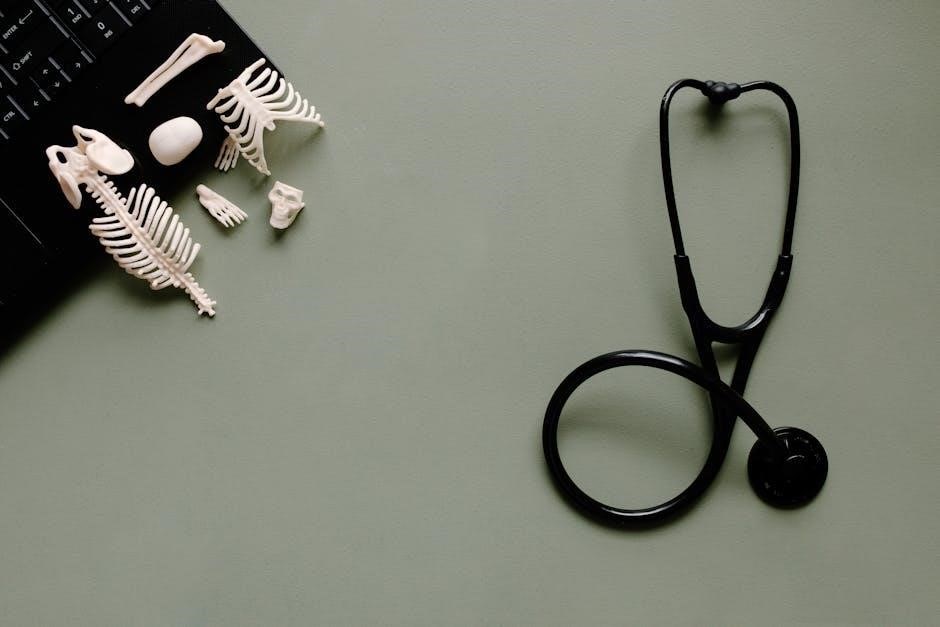
Pre-Lab Assignments and Answers
Pre-lab assignments and answers guide students through essential preparation, ensuring a solid understanding of anatomical and physiological concepts․ Review sheets and answer keys enhance learning and assessment readiness effectively․
Lab 1 introduces foundational concepts in anatomy and physiology, focusing on the scientific study of the human body․ Students explore basic anatomical terminology, body systems, and the hierarchical structure of organization․ Activities include identifying body cavities, directional terms, and planes of section․ The lab emphasizes the importance of microscopy and histology, with hands-on practice using microscopes to observe cellular structures․ Pre-lab assignments ensure preparation, while review sheets and answer keys provide clarity․ This lab sets the stage for understanding the inter relationships between body systems, equipping students with essential skills for further exploration in anatomy and physiology․ Key concepts like homeostasis and the scientific method are highlighted, forming a solid foundation for subsequent labs and studies․
Lab 2: Microscopy and Histology Basics
Lab 2 focuses on mastering microscopy and histology techniques, essential for examining cellular and tissue structures․ Students learn to properly use compound light microscopes, including adjusting focus, brightfield, and low-light settings․ The lab covers slide preparation, staining, and observation of histological samples․ Key activities include identifying epithelial, connective, muscle, and nervous tissues under magnification․ Pre-lab assignments review cell and tissue types, while review sheets reinforce microscopy best practices․ Post-lab questions assess understanding of histological structures and their functions․ This lab provides hands-on experience with microscopic anatomy, enabling students to distinguish between tissue types and understand their roles in the human body․ The skills gained are foundational for advanced studies in anatomy and physiology, emphasizing the practical application of microscopy in scientific exploration․
Lab 3: Surface Anatomy and Anatomical Terminology
Lab 3 introduces students to surface anatomy and anatomical terminology, focusing on identifying key landmarks on the human body and models․ Activities include locating structures such as the femoral pulse, patellar reflex, and pelvic girdle․ Students also learn to use directional terms like proximal, distal, and medial to describe body positions accurately․ The lab emphasizes understanding anatomical planes (sagittal, frontal, transverse) and quadrants for precise communication in scientific and clinical settings․ Pre-lab assignments include matching exercises to familiarize students with terminology, while review sheets reinforce concepts like ventral and dorsal cavities․ Post-lab questions assess the ability to identify and describe anatomical features, ensuring a solid foundation for further studies in human anatomy and physiology․
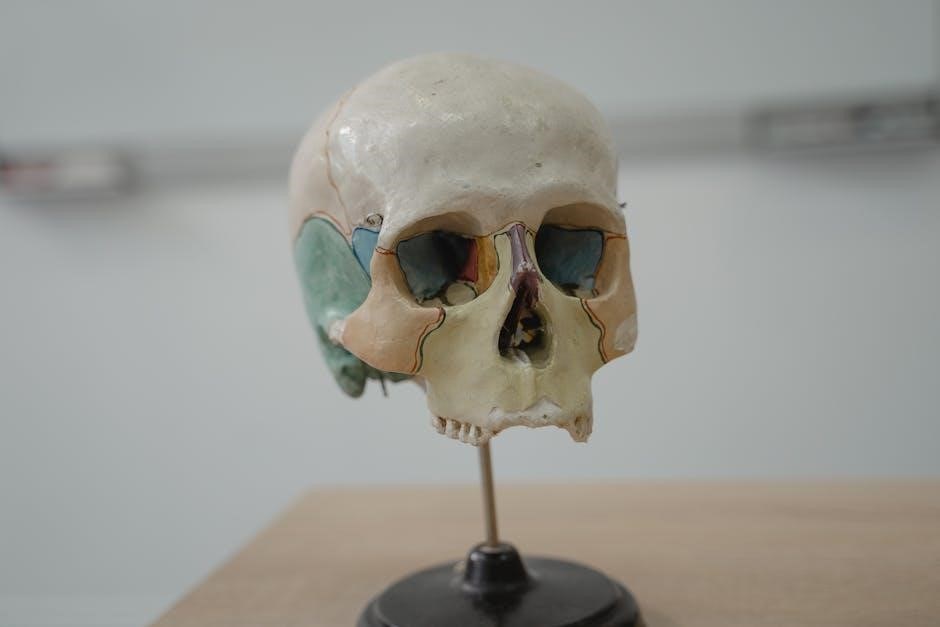
Lab Exercises and Activities
Lab exercises cover brain structure identification, cranial nerve functions, and skeletal-muscular system dissections․ Activities include interactive models, anatomical terminology practice, and hands-on learning to reinforce theoretical concepts effectively․
Exercise 1: Identifying Brain Structures
Exercise 1 focuses on identifying key brain structures, such as the cerebrum, cerebellum, and brainstem․ Students use classroom models and 3D anatomy tools to locate and label these structures․ The activity enhances understanding of brain organization and function․ Additional resources, like guided learning platforms, provide detailed views and descriptions․ This exercise helps students develop spatial reasoning and anatomical terminology skills․ By exploring brain structures, learners gain insights into their roles in controlling bodily functions, movement, and cognitive processes․ The lab manual includes answer keys and review sheets to ensure accurate identification and comprehension․ This hands-on approach reinforces theoretical knowledge, preparing students for advanced studies in neuroscience and related fields․
Exercise 2: Cranial Nerves and Their Functions
Exercise 2 delves into the identification and understanding of the 12 cranial nerves, each with distinct roles in sensory and motor functions․ Activities involve labeling diagrams, using 3D models, and tracing nerve pathways․ Key functions include controlling eye movements, facial expressions, and transmitting sensory information like taste and smell; Interactive tools and guided learning platforms enhance comprehension․ This exercise clarifies how cranial nerves integrate with the central nervous system, vital for processes like swallowing and hearing․ Answer keys and review questions reinforce learning, ensuring mastery of nerve functions and their clinical relevance․ Hands-on exploration aids in retaining complex anatomical details, preparing students for advanced neuroscience studies and practical applications in healthcare․ This foundational knowledge is essential for understanding the intricate communication networks within the human body․
Exercise 3: Skeletal and Muscular System Dissection
Exercise 3 focuses on the exploration of the skeletal and muscular systems through detailed dissection activities․ Students identify and examine bones, joints, and muscles, correlating their structure with function․ The exercise emphasizes understanding how muscles attach to bones, enabling movement․ Practical dissection of specimens or 3D models helps visualize anatomical relationships․ Key terms include origins, insertions, and actions of major muscles․ Activities also involve tracing the innervation and blood supply to muscles, reinforcing neurophysiological connections․ Review questions and answer keys provide reinforcement, ensuring mastery of muscle groups and their roles in locomotion and support․ This hands-on approach aids in developing a deeper appreciation for the interconnectedness of the skeletal and muscular systems, essential for understanding human movement and its clinical applications․
Review Sheets and Answer Keys
Review sheets and answer keys provide pre-lab quiz answers and post-lab questions, along with key terms and definitions, aiding students in mastering anatomy and physiology concepts effectively online․
Pre-Lab Quiz Answers
Pre-lab quizzes are essential for assessing students’ understanding of key anatomy and physiology concepts before lab activities․ These quizzes cover topics such as anatomical terminology, histology, and body systems․ Answers to pre-lab quizzes are provided in the lab manual, ensuring students can verify their knowledge and prepare effectively․ For example, quizzes on microscopy basics or surface anatomy help students grasp foundational principles․ The answer keys are often available online or in the textbook, making it easy for students to review and improve․ Instructors can also access these resources to track student progress․ By completing pre-lab quizzes, students develop a strong foundation for hands-on lab exercises, ensuring they are well-prepared to identify structures and perform dissections confidently․
Post-Lab Review Questions
Post-lab review questions are designed to reinforce learning after lab activities․ These questions cover topics such as brain structure identification, cranial nerve functions, and muscle dissection․ They help students apply theoretical knowledge to practical observations․ Answers are provided in the lab manual or online, enabling self-assessment․ For example, questions on skeletal and muscular systems ensure understanding of bone and joint anatomy․ Review questions also address histology and microscopy, aiding in retaining complex details․ Regularly reviewing these questions enhances critical thinking and prepares students for exams․ Instructors can use them to gauge student comprehension and identify areas needing further instruction․ Overall, post-lab review questions are a valuable tool for consolidating anatomy and physiology knowledge, ensuring long-term retention of key concepts and skills․
Key Terms and Definitions
Anatomy: The study of the internal structure of organisms and their parts․ Physiology: The study of the functions and processes of living organisms․ Skeletal System: Comprises bones and joints, providing support and protection․ Muscular System: Includes muscles that enable movement and maintain posture․ Nervous System: Controls body functions through nerve cells and fibers․ Cardiovascular System: Involves the heart and blood vessels, circulating blood throughout the body․ Histology: The study of tissue structure under a microscope․ Cranial Nerves: Twelve pairs of nerves originating from the brain, controlling various functions․ Surface Anatomy: The study of anatomical structures visible on the body’s surface․ Anatomical Terminology: Standardized terms describing body positions and movements․ These terms are essential for understanding lab exercises and pre-lab assignments, ensuring accurate identification of structures and their functions․
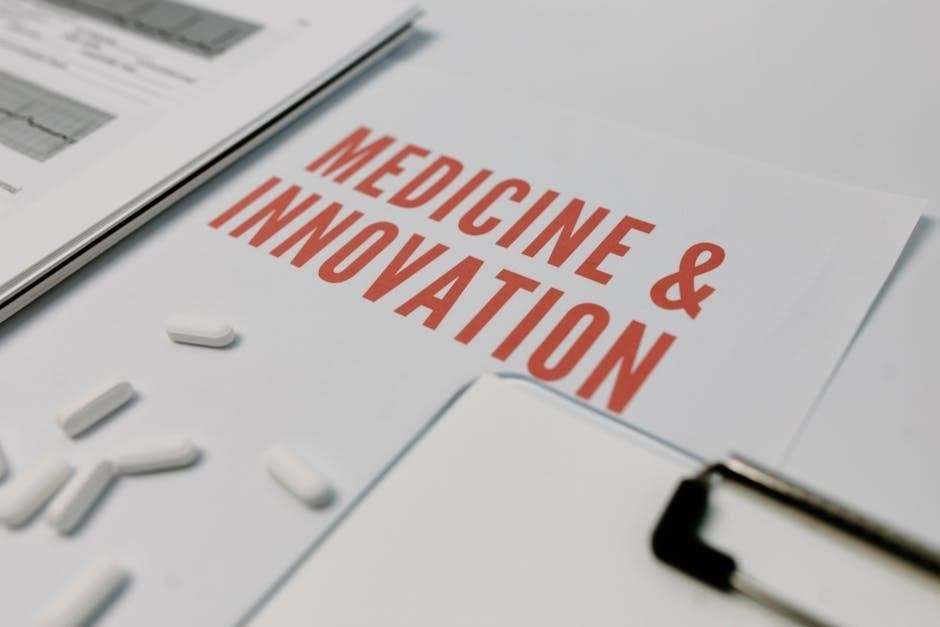
Human Body Systems
The human body is organized into systems like skeletal, muscular, nervous, and cardiovascular, each functioning collaboratively to maintain overall health and perform essential biological processes efficiently․
Skeletal System: Bones and Joints
The skeletal system comprises 206 bones and joints, providing structural support, protection for vital organs, and facilitating movement․ Bones are categorized into long (e․g․, femur), short (e․g․, carpals), flat (e․g․, skull bones), irregular (e․g․, vertebrae), and sesamoid bones (e;g․, patella)․ Joints, or articulations, allow for flexibility and mobility, classified as synovial, cartilaginous, or fibrous․ Synovial joints, like the knee, are the most movable, while fibrous joints, such as those in the skull, are immovable․ Ligaments and tendons connect bones, enabling stability and motion․ The skeletal system also produces blood cells in bone marrow and stores minerals like calcium․ Understanding bones and joints is crucial for anatomy and physiology studies, as they form the framework for the body’s structure and function, essential for movement and overall health․
Muscular System: Types of Muscles
The muscular system consists of three types of muscles: skeletal, smooth, and cardiac․ Skeletal muscles are voluntary, attached to bones, and responsible for movement, such as walking or writing․ Smooth muscles are involuntary, found in internal organs like the digestive tract, and regulate functions like digestion and blood pressure․ Cardiac muscle is specialized for the heart, enabling consistent and synchronized contractions to pump blood․ Each muscle type has distinct structures and functions, working together to maintain movement, posture, and internal processes․ Understanding these differences is essential for anatomy and physiology studies, as muscles play a vital role in the body’s ability to function and respond to stimuli․ This section provides detailed insights into the characteristics and roles of each muscle type, enhancing comprehension of the muscular system’s complexity and importance․
Nervous System: Structure and Function
The nervous system is a complex network of specialized cells and tissues that control and coordinate body functions․ It consists of the central nervous system (CNS), including the brain and spinal cord, and the peripheral nervous system (PNS), which includes nerves and ganglia․ The CNS processes information and integrates responses, while the PNS transmits signals between the CNS and the rest of the body․ Key structures like neurons, synapses, and neurotransmitters enable communication within the system․ The nervous system regulates voluntary actions, such as movement, and involuntary functions, like heart rate and digestion․ It also facilitates sensory perception, cognition, and memory․ Understanding its structure and function is crucial for anatomy and physiology studies, as it underpins the body’s ability to respond to internal and external stimuli effectively․
Cardiovascular System: Heart and Blood Vessels
The cardiovascular system is a vital network responsible for transporting blood throughout the body․ At its core is the heart, a muscular organ with four chambers: the right and left atria, and the right and left ventricles․ The right side of the heart pumps deoxygenated blood to the lungs, while the left side pumps oxygenated blood to the rest of the body․ Blood vessels, including arteries, veins, and capillaries, form the pathways for blood circulation․ Arteries carry blood away from the heart, veins return it, and capillaries facilitate the exchange of oxygen, nutrients, and waste products with tissues․ The cardiovascular system is essential for maintaining homeostasis, supporting cellular metabolism, and connecting the body’s systems․ Understanding its structure and function is fundamental for anatomy and physiology studies, as it underpins the body’s ability to sustain life and promote overall health․
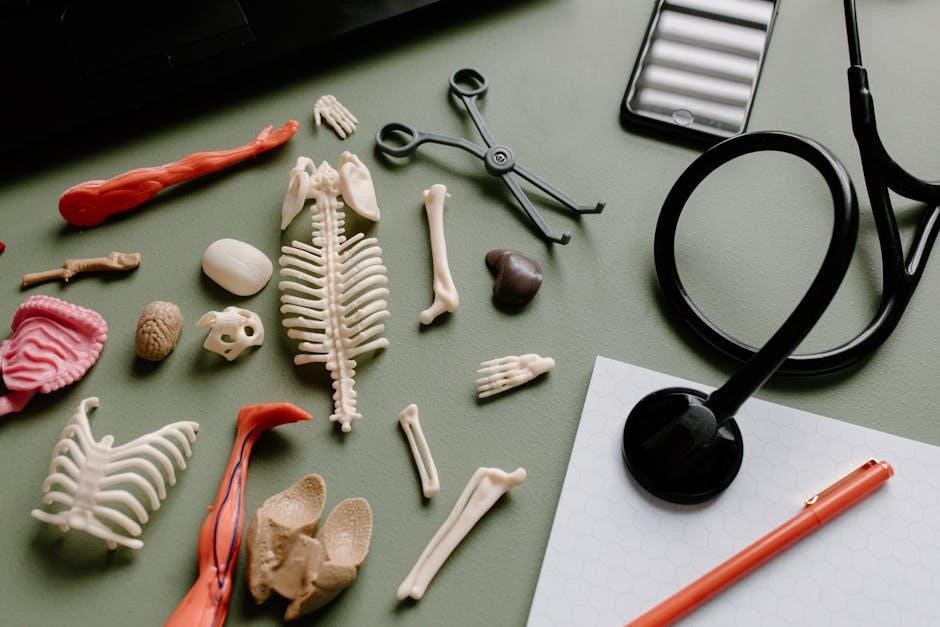
Additional Resources
Online platforms offer interactive anatomy models, while 3D anatomy tools provide detailed visualizations․ Solution manuals and guides are available for further study and reference, enhancing learning experiences for students and educators alike․
Connect Anatomy and Physiology Lab Manual Answers
Connect Anatomy and Physiology Lab Manual Answers is a comprehensive online resource designed to support students and instructors in anatomy and physiology courses․ It provides detailed solutions to pre-lab assignments, review sheets, and exercises, ensuring a deeper understanding of key concepts․ Compatible with major editions of anatomy and physiology lab manuals, this platform offers interactive tools and 3D models to enhance learning․ Users can access guided learning features, anatomical terminology, and virtual dissections, making it an invaluable resource for both classroom and self-study environments․ The platform also includes answer keys for instructors, ensuring accurate grading and feedback․ By integrating cutting-edge technology with traditional learning methods, Connect Anatomy and Physiology Lab Manual Answers bridges the gap between theory and practical application, fostering a more engaging and effective educational experience․
Online Platforms for Anatomy Learning
Online platforms for anatomy learning provide interactive and immersive tools to enhance understanding of human anatomy․ Websites like Kenhub and TeachMeAnatomy offer detailed anatomical guides, 3D models, and interactive diagrams․ These platforms allow users to explore anatomical structures virtually, making complex concepts more accessible․ Many platforms incorporate quizzes, flashcards, and practice questions to reinforce learning․ Additionally, some platforms, such as those linked to lab manuals, provide guided learning paths and virtual dissections․ These resources are particularly beneficial for students and professionals seeking to deepen their knowledge of anatomy․ By leveraging technology, online platforms create a dynamic and engaging environment for anatomy education, catering to diverse learning styles and preferences․
3D Anatomy Models and Tools
3D anatomy models and tools are revolutionary resources for visualizing and understanding human anatomy․ These models, often created by physicians and anatomy experts, allow users to explore over 6,000 anatomical structures in detail․ Platforms like Kenhub and TeachMeAnatomy offer interactive 3D views, enabling learners to rotate, zoom, and combine structures for a deeper understanding․ Many tools align with International Anatomical Terminology, ensuring accuracy․ Features such as guided learning paths and virtual dissections make these models invaluable for students and professionals․ Additionally, some platforms provide the ability to add, delete, or combine structures, catering to specific learning needs․ These tools are accessible on various devices, including web, iPad, iPhone, and Android, making anatomy education more accessible and engaging than ever before․ They complement lab manuals by providing a hands-on, visual approach to mastering complex anatomical concepts․
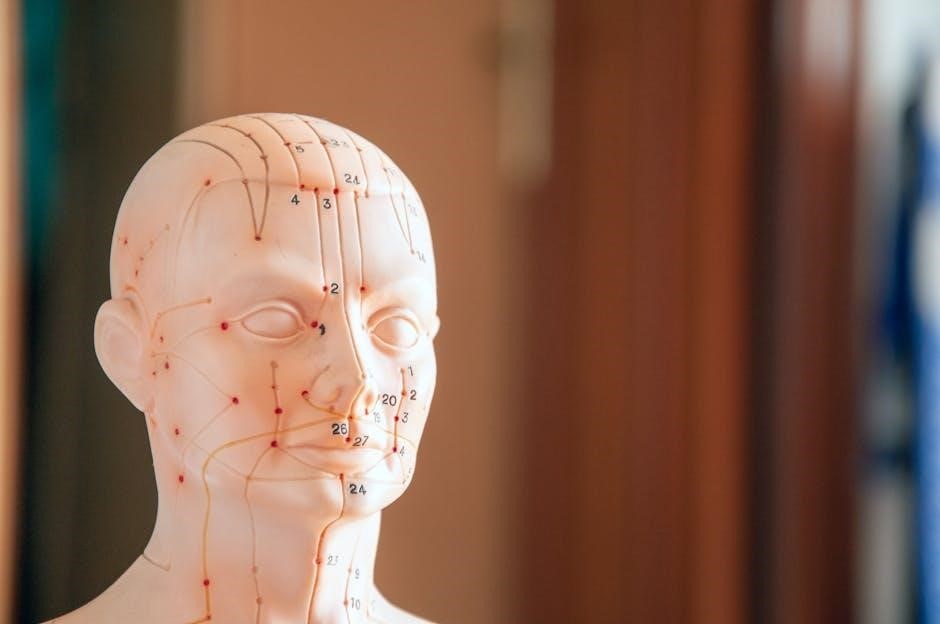
Answer Keys and Solution Manuals
Answer keys and solution manuals for anatomy and physiology lab manuals are available for instructors, providing pre-lab quiz answers, review sheets, and detailed solutions for various editions, including 5th, 7th, and 8th․
Lab Manual for Anatomy and Physiology 5th Edition
The 5th edition of the Anatomy and Physiology lab manual offers detailed exercises, pre-lab assignments, and review sheets․ It includes answers to quizzes and hands-on activities, covering skeletal, muscular, and nervous systems․ The manual features 3D anatomy models and online tools for enhanced learning․ Compatible with major textbook editions, it provides comprehensive solutions for instructors and students․ Additional resources include guided learning modules and interactive platforms for better understanding․ This edition is widely used in classrooms and is known for its clarity and thorough coverage of lab topics․ It is a valuable resource for both beginners and advanced learners in anatomy and physiology studies․
Lab Manual for Anatomy and Physiology 7th Edition
The 7th edition of the Anatomy and Physiology lab manual is a widely used resource that provides detailed answers to pre-lab and post-lab questions․ It includes comprehensive review sheets, key terms, and exercises for labs like skeletal system dissection and cranial nerve identification․ The manual is known for its updated content, featuring 3D anatomy models and interactive tools to enhance learning․ It covers essential topics such as histology basics, surface anatomy, and the structure of the brain․ This edition also includes access to online platforms for virtual labs and simulations, making it a versatile tool for both students and instructors․ The 7th edition is particularly praised for its clarity and organization, ensuring a deeper understanding of complex anatomical and physiological concepts․ It remains a go-to resource for those studying human anatomy and physiology․
Lab Manual for Anatomy and Physiology 8th Edition
The 8th edition of the Anatomy and Physiology lab manual offers a comprehensive learning experience with updated content and enhanced digital tools․ It includes detailed pre-lab and post-lab assignments, review sheets, and exercises for in-depth understanding․ This edition features improved visuals, such as high-resolution microscopy images and 3D anatomical models, to aid in complex topics like histology and neuroanatomy․ The manual also provides access to interactive simulations and virtual labs, allowing students to explore anatomical structures in a dynamic way․ Additionally, it includes expanded practice exercises for dissections of the skeletal and muscular systems․ The 8th edition is known for its improved organization, making it easier for students to navigate and cross-reference information․ It remains a trusted resource for both students and instructors, offering a blend of traditional and modern learning tools to master anatomy and physiology․
Comments